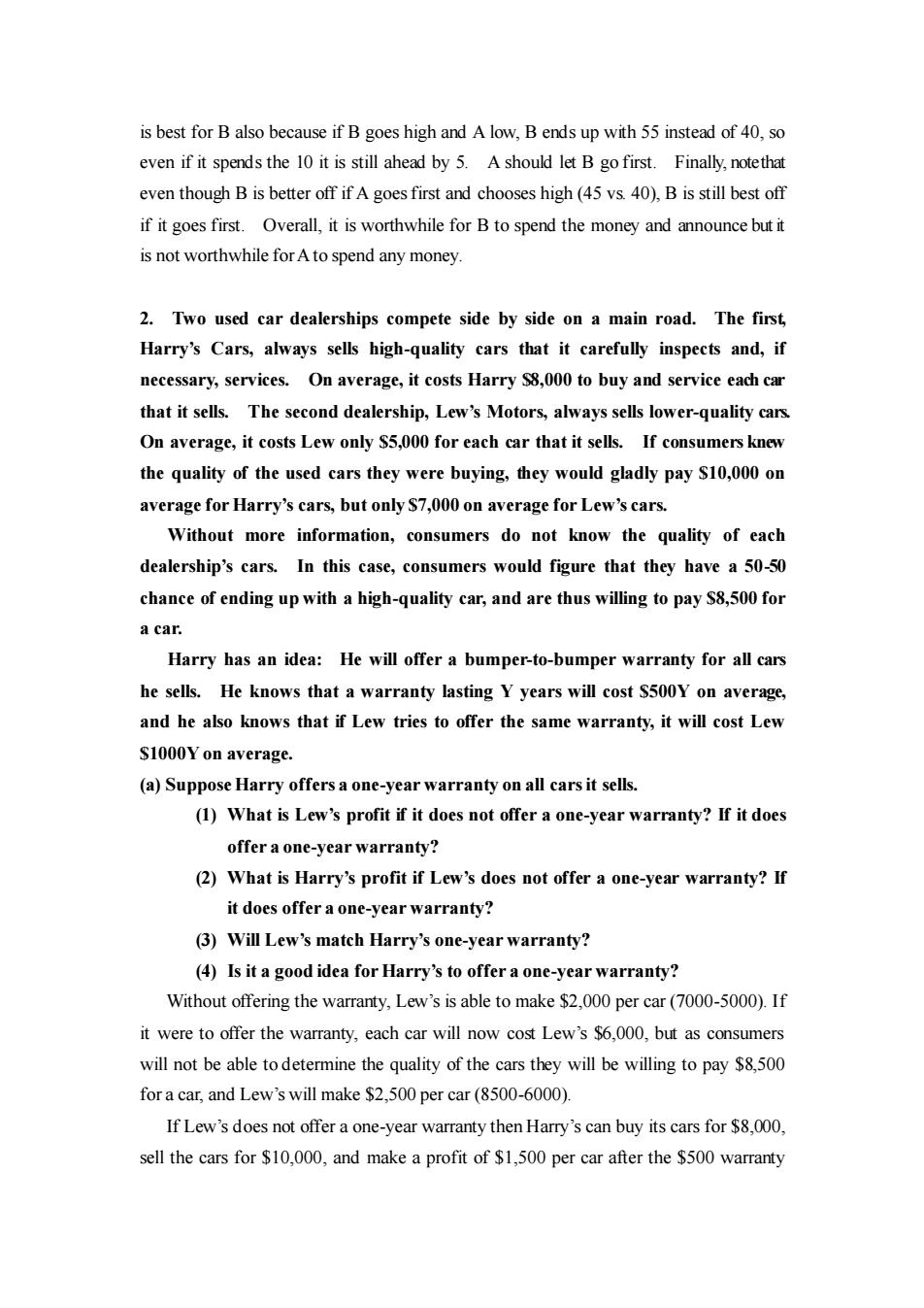正在加载图片...

is best for B also because if B goes high and A low,B ends up with 55 instead of 40,so even if it spends the 10 it is still ahead by 5.Ashould let B go first.Finally,notetha even though B is better off if A goes first and chooses high(45 vs 40),B is still best off if it goes first.Overall,it is worthwhile for B to spend the money and announce but it is not worthwhile for A to spend any money. 2.Two used car dealerships compete side by side on a main road.The first, Harry's Cars,always sells high-quality cars that it carefully inspects and,if necessary,services.On average,it costs Harry $8,000 to buy and service each car that it sells.The second dealership,Lew's Motors,always sells lower-quality cars. On average,it costs Lew only $5,000 for each car that it sells.If consumers knew the quality of the used cars they were buying,they would gladly pay $10,000 on average for Harry's cars,but only $7,000 on average for Lew's cars. Without more information,consumers do not know the quality of each dealership's cars.In this case,consumers would figure that they have a 50-50 chance of ending up with a high-quality car,and are thus willing to pay $8,500 for a car Harry has an idea:He will offer a bumper-to-bumper warranty for all cars he sells.He knows that a warranty lasting Y years will cost S500Y on average and he also knows that if Lew tries to offer the same warranty,it will cost Lew S1000Y on average. (a)Suppose Harry offers a one-year warranty on all cars it sells (1)What is Lew's profit if it does not offer a one-year warranty?If it does offer a one-year warranty? (2)What is Harry's profit if Lew's does not offer a one-year warranty?If it does offer a one-year warranty? (3)Will Lew's match Harry's one-year warranty? (4)Is it a good idea for Harry's to offer a one-year warranty? Without offering the warranty,Lew's is able to make $2,000 per car(7000-5000).If it were to offer the warranty,each car will now cost Lew's $6,000,but as consumers will not be able todetermine the quality of the cars they will be willing to pay $8500 for a car,and Lew's will make $2,500 per car(8500-6000) If Lew's does not offer a one-year warranty then Harry'scan buy its cars for 8.000 sell the cars for $10.000,and make a profit of $1,500 per car after the $500 warranty is best for B also because if B goes high and A low, B ends up with 55 instead of 40, so even if it spends the 10 it is still ahead by 5. A should let B go first. Finally, note that even though B is better off if A goes first and chooses high (45 vs. 40), B is still best off if it goes first. Overall, it is worthwhile for B to spend the money and announce but it is not worthwhile for A to spend any money. 2. Two used car dealerships compete side by side on a main road. The first, Harry’s Cars, always sells high-quality cars that it carefully inspects and, if necessary, services. On average, it costs Harry $8,000 to buy and service each car that it sells. The second dealership, Lew’s Motors, always sells lower-quality cars. On average, it costs Lew only $5,000 for each car that it sells. If consumers knew the quality of the used cars they were buying, they would gladly pay $10,000 on average for Harry’s cars, but only $7,000 on average for Lew’s cars. Without more information, consumers do not know the quality of each dealership’s cars. In this case, consumers would figure that they have a 50-50 chance of ending up with a high-quality car, and are thus willing to pay $8,500 for a car. Harry has an idea: He will offer a bumper-to-bumper warranty for all cars he sells. He knows that a warranty lasting Y years will cost $500Y on average, and he also knows that if Lew tries to offer the same warranty, it will cost Lew $1000Y on average. (a) Suppose Harry offers a one-year warranty on all cars it sells. (1) What is Lew’s profit if it does not offer a one-year warranty? If it does offer a one-year warranty? (2) What is Harry’s profit if Lew’s does not offer a one-year warranty? If it does offer a one-year warranty? (3) Will Lew’s match Harry’s one-year warranty? (4) Is it a good idea for Harry’s to offer a one-year warranty? Without offering the warranty, Lew’s is able to make $2,000 per car (7000-5000). If it were to offer the warranty, each car will now cost Lew’s $6,000, but as consumers will not be able to determine the quality of the cars they will be willing to pay $8,500 for a car, and Lew’s will make $2,500 per car (8500-6000). If Lew’s does not offer a one-year warranty then Harry’s can buy its cars for $8,000, sell the cars for $10,000, and make a profit of $1,500 per car after the $500 warranty